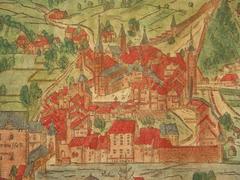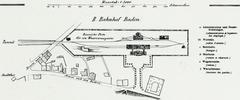Reformed Parish Church Baden: Visiting Hours, Tickets, and Historical Significance
Date: 04/07/2025
Introduction
Nestled in the historic heart of Baden, Switzerland, the Reformed Parish Church Baden (Reformierte Kirche Baden) is a powerful symbol of the town’s religious heritage, architectural elegance, and cultural vibrancy. Established in the wake of the Second Villmergen War in 1712, the church reflects the enduring presence of Protestant faith in a region long marked by religious diversity and political transformation. Built with stones from the dismantled Fortress Stein and designed by Abraham Dünz the Younger and master builder Franz Beer, the church’s harmonious Baroque architecture—guided by the Golden Ratio—mirrors its theological and cultural ideals. Today, the church serves not only as a place of worship but also as a lively community center, hosting concerts, cultural programs, and educational events that continue to enrich Baden’s social fabric.
This comprehensive guide provides essential information on visiting hours, accessibility, guided tours, and nearby attractions, ensuring a meaningful and memorable experience at this Swiss landmark. For the latest updates and planning resources, consult the official Baden tourism website and the Audiala app (Visiting the Reformed Parish Church Baden: History, Hours, and Travel Tips, Visiting the Reformed Parish Church in Baden: History, Architecture & Visitor Guide, Visiting the Reformed Parish Church Baden: Hours, Tickets & Historical Highlights).
Table of Contents
- Overview and Welcome
- Historical Background
- Architectural Highlights
- Cultural Significance and Community Role
- Visitor Information
- Musical and Cultural Events
- Nearby Attractions and Suggested Itinerary
- Photography and Visitor Etiquette
- Accessibility and Facilities
- Frequently Asked Questions (FAQ)
- Travel Tips
- Conclusion and Summary
- References
Overview and Welcome
Located at the heart of Baden’s picturesque old town, the Reformed Parish Church invites visitors to explore its rich history, striking architecture, and vibrant cultural life. Whether you are a history enthusiast, architecture admirer, or cultural traveler, this guide will help you plan your visit to one of Switzerland’s most significant Protestant landmarks.
Historical Background
The Reformed Parish Church of Baden was constructed in the aftermath of the Second Villmergen War (1712), a conflict that profoundly impacted Switzerland’s religious and political landscape. Following the Protestant victory, the peace treaty required Baden—a traditionally Catholic stronghold—to provide a place for Protestant worship. The church was built near Badstrasse, utilizing stones from the dismantled Fortress Stein, thus linking it to Baden’s medieval past.
Completed in 1714, the church’s opening coincided with the Baden Peace Congress, which helped end the War of the Spanish Succession. The first sermon was delivered by Pastor Johann Jakob Wolf on July 1, 1714, even though local Protestant congregational life had yet to fully develop (myCityHunt).
Architectural Highlights
Design and Construction
Abraham Dünz the Younger and Franz Beer designed the church in the Baroque style, with dimensions reflecting the Golden Ratio (27.4 meters long, 16.6 meters wide). The 32-meter-high tower, integrated with the façade, features a ground-floor hall connected to the main sanctuary (myCityHunt).
Centrality of the Pulpit
A hallmark of Reformed church design, the pulpit is centrally positioned and slightly elevated, emphasizing the primacy of preaching and the Word of God—a reflection of Reformation theology (Crossway).
Simplified Ornamentation
True to Reformed principles, the church’s interior is marked by restrained ornamentation. White walls, pale blue capitals, and delicate stucco profiles create a serene atmosphere, directing focus to the sermon and worship (Crossway).
Use of Light and Space
Large windows fill the nave with natural light, symbolizing enlightenment and community. The open, unsegmented space fosters unity among worshippers, contrasting with the hierarchical layouts of pre-Reformation churches.
Historical Layers
Elements from earlier architectural styles, such as Romanesque or Gothic arches and stonework, are visible, reflecting the church’s evolution through centuries of religious change.
Cultural Significance and Community Role
Center of Civic and Spiritual Life
The church is not only a religious site but also a cornerstone of Baden’s civic identity, hosting significant community events, cultural gatherings, and educational programs (Studying in Switzerland).
Music and Community Events
With its renowned organ (built by Orgelbau Kuhn in 1968) and a harmonious five-bell chime, the church is a center for musical performances. Local choirs and concert series attract thousands annually, reinforcing the church’s role as a cultural hub (EKiBa, p. 2).
Ecumenical and Cross-Border Connections
Baden’s proximity to France and Germany has fostered ecumenical cooperation and European partnerships, symbolized by the nearby Europe Bridge and ongoing dialogue with Catholic and Protestant neighbors (EKiBa, p. 2).
Educational and Social Outreach
The church actively promotes religious education, social welfare, and intercultural projects, employing thousands and serving a large regional community (EKiBa, p. 4, 8).
Visitor Information
Opening Hours and Admission
- Monday–Saturday: 9:00 AM – 5:00 PM
- Sunday: 1:00 PM – 5:00 PM (limited access during services)
- Admission: Free. Donations are appreciated.
Guided Tours
Guided tours are available by request, often in German with English options for private groups. Tours offer deeper insights into the church’s history, architecture, and Reformation significance. Advance booking is recommended—especially during peak travel seasons (deinbaden.ch).
Location
- Address: Spitalwiese near Badstrasse, Baden
- Access: 10-minute walk from Baden railway station; well-connected by public transport and close to public parking garages (Mapcarta).
Musical and Cultural Events
The church regularly hosts concerts, lectures, and community gatherings. Its excellent acoustics and welcoming space make it ideal for performances. For event schedules, consult the Baden tourism calendar.
Nearby Attractions and Suggested Itinerary
Enhance your visit by exploring:
- Old Town Baden: Medieval streets, Stadtturm clock tower, local shops, and cafés (switzerlanding.com).
- Stein Castle Ruins: Scenic hiking and panoramic views.
- Thermal Baths: Modern FORTYSEVEN spa and historic bathhouses (audiala.com).
- History Museum of Baden: Exhibits on Roman, medieval, and modern history.
- Synagogue of Baden: Testifying to the town’s religious diversity.
A recommended itinerary: morning visit to the church, old town stroll, lunch at a local bistro, afternoon at the museum or baths.
Photography and Visitor Etiquette
- Photography: Permitted without flash; avoid tripods and be discreet, especially during services or private events.
- Dress Code: Modest attire with shoulders and knees covered. Remove hats inside the sanctuary.
- Conduct: Maintain a quiet and respectful demeanor.
Accessibility and Facilities
- Wheelchair Access: Main entrance is wheelchair accessible; some old town streets may be cobblestone or uneven.
- Restrooms: Not available on-site; public facilities nearby.
- Cafés/Shops: Located in the surrounding old town.
- Assistance: Contact the church or tourism office for accessibility arrangements (deinbaden.ch).
Frequently Asked Questions (FAQ)
Q: What are the visiting hours of the Reformed Parish Church Baden?
A: Monday–Saturday, 9:00 AM–5:00 PM; Sunday, 1:00 PM–5:00 PM. Times may vary during events.
Q: Is there an entrance fee?
A: No, admission is free. Donations are welcome.
Q: Are guided tours available?
A: Yes, in German and by request in English.
Q: Is the church wheelchair accessible?
A: Yes, but some surrounding streets may be uneven.
Q: Can I take photos inside?
A: Yes, but avoid flash and be respectful during services.
Q: What else should I visit nearby?
A: Old town, Stein Castle ruins, thermal baths, and local museums.
Travel Tips
- Plan your visit outside peak service times for a quieter experience.
- Combine your visit with nearby attractions for a full day in Baden.
- Use public transport for convenience, as parking can be limited.
- Check event schedules online and consider attending a concert for a unique experience.
- Learn a few German phrases to enhance your visit, though English is widely understood.
Conclusion and Summary
A visit to the Reformed Parish Church Baden offers an immersive journey into Switzerland’s religious, cultural, and architectural heritage. As a monument born from the shifting tides of religious tolerance and Baroque artistry, the church stands as a beacon of unity and community in Baden. Open to all with free admission, it invites exploration through guided tours, concerts, and community events. The church’s central location, accessibility features, and proximity to other historical sites make it an essential part of any Baden itinerary. For the latest information and travel planning, consult the official Baden tourism website and enhance your visit with the Audiala app.
References and Further Reading
- Visiting the Reformed Parish Church Baden: History, Hours, and Travel Tips
- Visiting the Reformed Parish Church in Baden: History, Architecture & Visitor Guide
- Visiting the Reformed Parish Church Baden: Hours, Tickets & Historical Highlights
- Visiting the Reformed Parish Church of Baden: Hours, Tickets & Nearby Historical Sites

